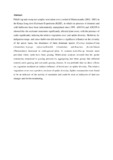INFLUENCE OF GRAZING BY LARGE MAMMALS ON THE SPIDER COMMUNITY OF A KENYAN SAVANNA BIOME
Abstract
Pitfall trap and sweep net samples were taken over a period of fifteen months (2002– 2003) in the Kenya Long-term Exclosure Experiment (KLEE), in which the presence of domestic and wild herbivores have been independently manipulated since 1995. ANOVA and ANCOVA showed that the exclosure treatments significantly affected plant cover, with the presence of cattle significantly reducing the relative vegetation cover and spider diversity. Herbivory by indigenous mega- and meso–herbivores did not have a significant influence on the diversity of the spider fauna, but abundance of three dominant species (Cyclosa insulana Costa (Araneidae), Argiope trifasciata Forskål (Araneidae) and Runcinia flavida Simon (Thomisidae)) decreased in cattle-grazed plots. In contrast, Aelurillus sp. became more prevalent where cattle have been grazing. Multivariate analyses revealed that the spider community responded to grazing pressure by aggregating into three groups that reflected control, cattle grazing and non-cattle grazing clusters. It was probable that the direct effects on vegetation mediated an indirect influence of herbivores on spider diversity. The relative vegetation cover was a positive predictor of spider diversity. Spider communities were found to be an indicator of the activity of mammals and could be used as indicators of land use changes and for bio-monitoring.
URI
http://www.bioone.org/doi/abs/10.1636/CT05-43.1?journalCode=arachttp://hdl.handle.net/123456789/2957
https://doi.org/10.1636/CT05-43.1
Collections
- Journal Articles (PAS) [303]

